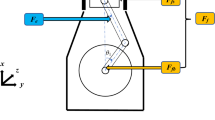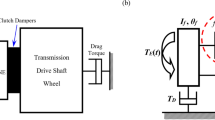Abstract
The torsional vibration of engine crankshaft is affected by many nonlinear factors, such as unbalanced external force (combustion pressure, friction resistance), nonlinear stiffness, unbalanced moment of inertia and self-excited oscillation considering velocity feedback. In the traditional numerical calculation methods, the simultaneous introduction of multiple nonlinear factors may lead to the divergence of calculation results, which may not be able to accurately evaluate the nonlinear dynamic bifurcation behavior. Therefore, the current researches focus on the influence of a single nonlinear factor on torsional vibration. Motivated by such limitations, dynamic behavior analysis of torsional vibration of an engine crankshaft model considering multiple nonlinear factors is investigated in this work, including the in-cylinder combustion, lubricating oil lubrication, bearing friction, in-cylinder piston ring friction, valve seat percussion, variable inertia and angular displacement as well as angular velocity feedback. For this purpose, a nonlinear crankshaft closed-loop self-excitation coupled oscillation (NCSCO) model is established. On the basis of verifying the correctness of the model through comparison with experiments, an improved Newmark-β integral method which has a better convergence is proposed to solve the model in a longer time domain. The correctness of it is verified through the comparison of results solved using traditional Runge–Kutta method. Based on this, Sobol method is performed for sensitivity analysis and dynamic bifurcation characteristics are explored through a series of numerical simulations. Abundant ‘jumping’ phenomena are obtained and the appropriate range of parameters is given based on bifurcation diagrams.















Similar content being viewed by others
Data availability
The datasets analyzed during the current study are available from the corresponding author on reasonable request.
References
Niu, W.Y., Li, Q., Zhou, X.C.: (2015) Theoretical research on ship shafting torsional vibration based on power flow theory. IEEE 3rd Int Conference Transportation Information Safety, Wuhan, China. https://doi.org/10.1109/ictis.2015.7232139
Han, H.S., Lee, K.H., Park, S.H.: Parametric study to identify the cause of high torsional vibration of the propulsion shaft in the ship. Eng. Fail. Anal. 59, 334–346 (2016). https://doi.org/10.1016/j.engfailanal.2015.10.018
Wen, X.F., Yuan, Q., Lu, J.S., Cui, Z.D.: Analysis of propulsion shafting torsional vibration of vessels with double engines and double propellers. Adv. Mat. Res. 479, 1310–1313 (2012). https://doi.org/10.4028/www.scientific.net/AMR.479-481.1310
Tan, W., Cong, Z., Zhe, T., Yan, X.: (2015) Analysis of Torsional Vibration of Large-Scale Ship Propulsion Shafting. In: 34th ASME International Conference on Ocean, Offshore and Arctic Engineering, St. John's, Canada. https://doi.org/10.1115/OMAE2015-42392
Wang, M., Xiao, N., Fan, M.: The torsional vibration simulation of the diesel engine crankshaft system based on multi-body dynamic model. Proc. Inst. Mech. Eng. Part K J. Mul. Dyn. 235, 443–451 (2021). https://doi.org/10.1177/14644193211020247
Wang, F., Xia, J., Xu, X., Cai, Y., Ni, S., Que, H.: Torsional vibration-considered energy management strategy for power-split hybrid electric vehicles. J. Cleaner Prod. 296, 1–16 (2021). https://doi.org/10.1016/j.jclepro.2021.126399
Tametang Meli, M.I., Yemélé, D., Leutcho, G.D.: Dynamical analysis of series hybrid electric vehicle powertrain with torsional vibration: Antimonotonicity and coexisting attractors. Chaos. Soliton Fract. 150, 1–10 (2021). https://doi.org/10.1016/j.chaos.2021.111174
Liu, C., Jiang, D.: Torsional vibration characteristics and experimental study of cracked rotor system with torsional oscillation. Eng. Fail. Anal. 116, 1–16 (2020). https://doi.org/10.1016/j.engfailanal.2020.104737
Han, H.S., Lee, K.H.: Experimental verification for lateral-torsional coupled vibration of the propulsion shaft system in a ship. Eng. Fail. Anal. 104, 758–771 (2019). https://doi.org/10.1016/j.engfailanal.2019.06.059
Haris, A., Motato, E., Theodossiades, S., Rahnejat, H., Kelly, P., Vakakis, A., Bergman, L.A., McFarland, D.M.: A study on torsional vibration attenuation in automotive drivetrains using absorbers with smooth and non-smooth nonlinearities. Appl. Math. Model. 46, 674–690 (2017). https://doi.org/10.1016/j.apm.2016.09.030
Haris, A., Alevras, P., Mohammadpour, M., Theodossiades, S., Mahony, M.O.: Design and validation of a nonlinear vibration absorber to attenuate torsional oscillations of propulsion systems. Nonlinear Dyn. 100, 33–49 (2020). https://doi.org/10.1007/s11071-020-05502-z
Motato, E., Haris, A., Theodossiades, S., Mohammadpour, M., Rahnejat, H., Kelly, P., Vakakis, A.F., McFarland, D.M., Bergman, L.A.: Targeted energy transfer and modal energy redistribution in automotive drivetrains. Nonlinear Dyn. 87, 169–190 (2017). https://doi.org/10.1007/s11071-016-3034-4
Ni, S.W., Guo, Y.B., Li, W.Y., Wang, D.H., Shuai, Z.B., Yu, D.H.: Effect of advanced injection angle on diesel engine shaft torsional vibration. Int. J. Engine Res. 22, 1–8 (2020). https://doi.org/10.1177/1468087419895932
Jiang, S., Li, W., Xin, G., Sheng, L., Fan, M., Yang, X.: Analysis of torsional vibration characteristics and time delay feedback control of semi-direct drive cutting transmission system in shearer. Chaos. Soliton Fract. 132, 1–12 (2020). https://doi.org/10.1016/j.chaos.2020.109607
Chen, X., Wei, H., Deng, T., He, Z., Zhao, S.: Investigation of electromechanical coupling torsional vibration and stability in a high-speed permanent magnet synchronous motor driven system. Appl. Math. Model. 64, 235–248 (2018). https://doi.org/10.1016/j.apm.2018.07.030
Uspensky, B., Avramov, K., Liubarskyi, B., Andrieiev, Y., Nikonov, O.: Nonlinear torsional vibrations of electromechanical coupling of diesel engine gear system and electric generator. J. Sound Vibr. 460, 1–25 (2019). https://doi.org/10.1016/j.jsv.2019.114877
Yan, D.L., Wang, W.Y., Chen, Q.J.: Fractional-order modeling and dynamic analyses of a bending-torsional coupling generator rotor shaft system with multiple faults. Chaos. Soliton Fract. 110, 1–15 (2018). https://doi.org/10.1016/j.chaos.2018.03.015
Zhang, H.B., Wang, J.K., Chen, G.Q., Yan, C.K.: A new hybrid control scheme for an integrated helicopter and engine system. Chin. J. Aeronaut. 25, 533–545 (2012). https://doi.org/10.1016/S1000-9361(11)60417-2
Sun, T., Tan, J., Wang, H.: Investigation of rotor control system loads. Chin. J. Aeronaut. 26, 1114–1124 (2013). https://doi.org/10.1016/j.cja.2013.07.029
Guo, Y.B., Li, W.Y., Yu, S.W., Han, X., Yuan, Y.B., Wang, Z.P., Ma, X.Z.: Diesel engine torsional vibration control coupling with speed control system. Mech. Syst. Signal Proc. 94, 1–13 (2017). https://doi.org/10.1016/j.ymssp.2017.01.017
Guerrero, D.P., Jiménez-Espadafor, F.J.: Torsional system dynamics of low speed diesel engines based on instantaneous torque: Application to engine diagnosis. Mech. Syst. Signal Proc. 116, 858–878 (2019). https://doi.org/10.1016/j.ymssp.2018.06.051
Liu, S., Li, W., Shuai, Z., Chen, M.: Vibration analysis of a single-cylinder reciprocating compressor considering the coupling effects of torsional vibration. Shock. Vib. (2019). https://doi.org/10.1155/2019/3904595
Tromme, E., Sonneville, V., Guest, J.K., Brüls, O.: System-wise equivalent static loads for the design of flexible mechanisms. Comput. Methods Appl. Mech. Eng. 329, 312–331 (2018). https://doi.org/10.1016/j.cma.2017.10.003
Reinisch, J., Wehrle, E., Achleitner, J.: Multiresolution topology optimization of large-deformation path-generation compliant mechanisms with stress constraints. Appl. Sci. 21, 1–27 (2021). https://doi.org/10.3390/app11062479
Dopico, D., Gonzaelez, F., Cuadrado, J., Kovecses, J.: Determination of holonomic and nonholonomic constraint reactions in an index-3 augmented Lagrangian formulation with velocity and acceleration projections. J. Comput. Nonlinear Dyn. 9, 1–9 (2014). https://doi.org/10.1115/1.4027671
Li, T., Du, W., Piao, M., Guo, Y., Jin, S., Nie, C., Fang, J., Cheng, Y., Fan, J.: Dynamical effect investigations of component’s internal interface by using techniques of rigid-flex coupling simulation. Shock. Vib. (2021). https://doi.org/10.1155/2021/6509950
He, L.L., Li, R.L.: Dynamical analysis for mechanical arm of the coal sampling machine based on rigid-flexible coupling model. Adv Mat Res. 605–607, 1172–1175 (2012). https://doi.org/10.4028/www.scientific.net/AMR.605-607.1172
Haug, E.J., Negrut, D., Lancu, M.: A state-space-based implicit integration algorithm for differential-algebraic equations of multibody dynamics. Mech. Struct. Mater. 25, 311–334 (1997). https://doi.org/10.1080/08905459708905292
Negrut, D., Ortiz, J.L.: A practical approach for the linearization of the constrained multibody dynamics equations. J. Comput. Nonlinear Dyn. 1, 230–239 (2006). https://doi.org/10.1115/1.2198876
Yucesan, Y.A., Viana, F.A.C., Manin, L., Mahfoud, J.: Adjusting a torsional vibration damper model with physics-informed neural networks. Mech. Syst. Signal Proc. 154, 1–16 (2021). https://doi.org/10.1016/j.ymssp.2020.107552
Pu, G., Xiang, C., Liu, H., Zhou, H.: Reducing variable frequency vibrations in a powertrain system with an adaptive tuned vibration absorber group. J. Sound Vibr. 425, 82–101 (2018). https://doi.org/10.1016/j.jsv.2018.03.034
Ahmadabadi, Z.N.: Nonlinear energy transfer from an engine crankshaft to an essentially nonlinear attachment. J. Sound Vibr. 443, 139–154 (2018). https://doi.org/10.1016/j.jsv.2018.11.040
Zweiri, Y.H., Whidborne, J.F., Seneviratne, L.D.: Instantaneous friction components model for transient engine operation. Proc. Inst. Mech. Eng. Part D J. Automob. Eng. 214, 809–824 (2000). https://doi.org/10.1243/0954407001527664
Liu, G., Liu, J.K., Chen, Y.M.: An improved algorithm for nonlinear dynamic systems based on Wilson-θ and Newmark-β method. Chin. J. Comput. Mech. 34, 433–439 (2017)
Yan, D.L., Chen, Q.J., Zheng, Y., Liu, W.Y.: Parameter sensitivity and dynamic characteristic analysis of bulb hydro generating unit with shaft crack fault. Mech. Syst. Signal Proc. 158, 1–33 (2021). https://doi.org/10.1016/j.ymssp.2021.107732
Lee, H.J., Shim, J.K.: Multi-objective optimization of a dual mass flywheel with centrifugal pendulum vibration absorbers in a single-shaft parallel hybrid electric vehicle powertrain for torsional vibration reduction. Mech. Syst. Signal Proc. 163, 1–16 (2022). https://doi.org/10.1016/j.ymssp.2021.108152
Nossent, J., Elsen, P., Bauwens, W.: Sobol’ sensitivity analysis of a complex environmental model. Environ. Modell. Softw. 26, 1515–1525 (2011). https://doi.org/10.1016/j.envsoft.2011.08.010
Maroteaux, F., Saad, C., Aubertin, F.: Development and validation of double and single Wiebe function for multi-injection mode diesel engine combustion modelling for hardware-in-the-loop applications. Energy Convers. Manag. 105, 630–641 (2015). https://doi.org/10.1016/j.enconman.2015.08.024
Zweiri, Y.H., Whidborne, J.F., Seneviratne, L.D.: Detailed analytical model of a single-cylinder diesel engine in the crank angle domain. Inst. Mech. Eng. Part D J. Automob. 215, 1197–1216 (2001). https://doi.org/10.1243/0954407011528734
Acknowledgements
This work is supported by the National Natural Science Foundation of China (Grant nos. 11972125 and 12102101)
Author information
Authors and Affiliations
Corresponding author
Ethics declarations
Conflict of interest
The authors declare no conflict of interest in preparing this article. The datasets generated during and/or analyzed during the current study are available from the corresponding author on reasonable request.
Human and animal rights
No human or animal subjects were used in this work.
Additional information
Publisher's Note
Springer Nature remains neutral with regard to jurisdictional claims in published maps and institutional affiliations.
Rights and permissions
Springer Nature or its licensor (e.g. a society or other partner) holds exclusive rights to this article under a publishing agreement with the author(s) or other rightsholder(s); author self-archiving of the accepted manuscript version of this article is solely governed by the terms of such publishing agreement and applicable law.
About this article
Cite this article
Ma, K., Du, J. & Liu, Y. Nonlinear dynamic behavior analysis of closed-loop self-excited crankshaft model using improved Newmark-β method. Nonlinear Dyn 111, 5107–5124 (2023). https://doi.org/10.1007/s11071-022-08100-3
Received:
Accepted:
Published:
Issue Date:
DOI: https://doi.org/10.1007/s11071-022-08100-3




